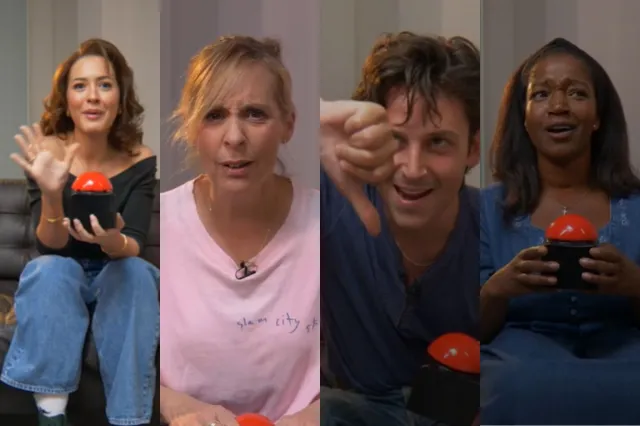A Disappearing Number
This is the third incarnation of Complicité’s multi-award-winning production, but the show has lost none of its brilliance since it was last seen at the Barbican in 2008.
Two great romances are presented to us via the complex and beautiful mathematics that underpins them. Taking place simultaneously in Chennai and London, Cambridge and Bangalore, as well as in the present and the past, these stories explore the human desire to understand our place in the universe.
Simon McBurney’s company makes innovative use of projection alongside simple, recurring choreography to move the action in space and time while maintaining a crucial sense of connectedness between each of the protagonists.
Nitin Sawhney’s pulsing score feels underused and there are a couple of moments of contrived theatricality here, but A Disappearing Number is an engrossing piece of work that will move you as much as it makes you think.
– Jo Caird
NOTE: The following FOUR-STAR review dates from 10 October 2008 and the production’s run at the Barbican.
It’s back, and it’s still beautiful. Complicite’s award-winning theatre piece of mathematics and mysticism, devised by the company and conceived and directed by Simon McBurney, has returned intact – with the same cast — to the Barbican where it played to full houses and rave reviews last autumn.
I still sense a yawning gap at the centre in the understated relationship (perhaps that is the point), around the First World War, between the Cambridge mathematician G H Hardy and the brilliant Brahmin autodidact Srinivasa Ramanujan. But I hadn’t previously fully grasped how the metaphor of maths can so poignantly indicate the sadness of a barren marriage – not theirs, but of a contemporary conventional couple — in which one plus one fails to add up to three.
The switch between locations and indeed media of drama, dance and film footage is as fleetly managed as before and I love the way in which the exuberance of technical discovery and information is matched with a haunting melancholy at the infinity of time, space and divergent numerical series. And when real life does push through, the maths provide a sort of rational consolation in disaster, death and tragedy.
The opening sequence in the lecture hall remains a modern classic of audience-baiting exposition, with Saskia Reeves explaining the by-ways of numerical series and terrifying calculus with the cheery bounciness of an Open University lecturer, joined by Paul Bhattacharjee’s physicist placing this “turn” in the wider historical narrative that subsequently operates like a pincer movement on the central revelations pure science, even weaving in a reference to the Mumbai bombs attacks two years ago.
The magical music of Nitin Sawhney is now played on the tabla by Hiren Chate, and the lighting and projections of Paul Anderson and sound of Christopher Shutt remain a source of wonder in their technical precision and, yes, mathematical accuracy. This is the nearest the British theatre has come to emulating the best of Robert Lepage, and it does not wilt in that comparison. This is the highest compliment I can muster.
-Michael Coveney
NOTE: The following FOUR-STAR review dates from 12 September 2007.
The mystery of mathematics for most of us means memories of algebra lessons at school, or the dismay with which we learned that, having scraped through O-Level maths by two marks, there loomed another O-Level hurdle of additional maths (I fluked that, too, by one mark).
But the mystery of maths at the highest level turns out to be a thing of real beauty in A Disappearing Number, Simon McBurney’s intriguing, very beautiful new show for Complicite, co-produced with the Barbican, Theatre Royal Plymouth, and festivals in Vienna and Amsterdam.
The hinge is the remarkable friendship, around the First World War, between the Cambridge mathematician GH Hardy, who believed that mathematicians were only makers of patterns, like poets and painters, and the Brahmin vegetarian autodidact Srinivasa Ramanujan. The air of magical contrivance is sustained by encasing this friendship in the expositions of a narrator physicist and a Hardy disciple many years later.
The extraordinary formula of a series of numbers adding up to a mere twelfth (the subject of Ramanujan’s first letter to Hardy) remains mind-bendingly baffling, but an audience is pleasantly seduced, and never patronised, by the problems of zero, the partitioning of integers and other such phenomena, while the story develops.
The physicist (Paul Bhattacharjee) even plays the old numbers game of showing how we are all thinking of the same one at the same time. The disciple Ruth (Saskia Reeves) boldly declares that one plus one equals three: she’s pregnant! Prime numbers are the bones of maths; the flesh is the infinite system of equations and theorems that not so much defy logic as make logic seem inadequate to understanding.
Ruth is in bed with both her subject and an Asian businessman in the futures markets who, in turn, is trying to have a telephone number changed in long-haul conversations with a BT operative in Bangalore.
That number echoes a taxi cab number in another part of the narrative – 1729 – which Ramanujan (the delightful Firdous Bamji) casually identifies as the result of two cubes multiplied in two different ways.
Nothing is accidental in numbers, as it is in life. In a richly various musical soundtrack, composer Nitin Sawhney has written a wonderful maths rap, danced with rigid muscularity, and the lighting and projections of Paul Anderson and Sven Ortel takes us fleetly from lecture halls to the teeming streets of Madras and the quiet majesty of Trinity College where Hardy (David Annen) pores over his papers. Now, if you’ll excuse me, I must return to my fractions.
– Michael Coveney












